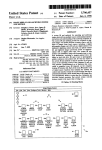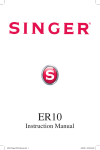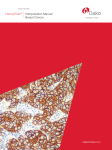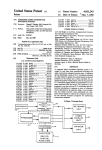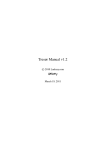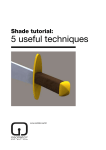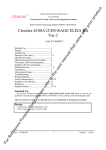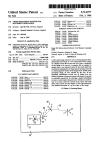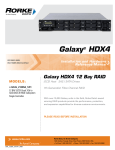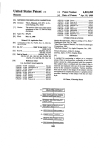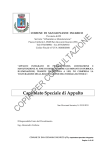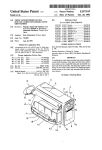Download A computerized pattern development system capable of direct
Transcript
US005341305A United States Patent [19] Clarino et a1. [11] [45] [54] 4,963,703 10/1990 Phillips et a1. . A COMPUTERIZED PATI‘ERN DEVELOPMENT SYSTEM CAPABLE OF DIRECT DESIGNER INPUT Patent Number: Date of Patent: 5,089,971 2/ 1992 5,341,305 Aug. 23, 1994 Gerber ................ .. .. 364/470 5,172,326 12/ 1992 Campbell, Jr. et a1 .. 364/470 5,175,806 12/ 1992 Muskovitz et al. ............... .. 395/ 125 [75] Inventors: Thomas N. Clarino, East Haven; FOREIGN PATENT DOCUMENTS Mary M. Altshul, South Windsor, both of Conn. [73] Assignee: Gerber Garment Technology, Inc., Tolland, Conn. [21] Appl. No.: 694,666 May 2, 1991 [22] Filed: Int. 01.5 ............................................ .. G06F 15/46 [51] [52] Us. (:1. .................................. .. 364/470; 364/468; 364/474.24 [5 8] Field of Search ............. .. 364/470, 468, 469, 471, 364/474.24; 395/125 [56] References Cited U.S. PATENT DOCUMENTS 3,391,392 3,473,157 3,534,396 3,596,068 3,766,528 3,81 1,113 3,887,903 3,895,355 3,924,244 4,058,849 4,149,246 4,451,895 4,539,585 4,546,434 4,552,991 4,570,033 4,578,376 4,807,143 4,853,715 4,961,149 7/1968 10/1969 10/1970 7/1971 10/1973 5/1974 6/1975 7/1975 12/1975 11/1977 4/1979 5/1984 9/1985 10/1985 1l/1985 2/1986 7/1986 2/1989 8/1989 10/1990 Doyle . 4013836 10/1991 Fed. Rep. of Germany . 4100534 1/ 1992 Fed. Rep. of Germany . 85634A/89 ofOOOO Italy . 1221349 ofOOOO Italy . 2050658 of 0000 United Kingdom . OTHER PUBLICATIONS Lisa Cedrone, CAD/CAM Marches On, pp. 82-86, Bobbin, Jan. 1991. AccuMark 300 User’s Manual, Document No. 05231-003, Issue No. 3, Apr. 1989, Chapter 6, by Ger bar Garment Technology, Inc. Primary Examiner-Jerry Smith Assistant Examiner--Jim Trammell Attorney, Agent, or Firm--McCormick, Paulding & Huber Little et a1. . Hart et a1. . [57] Doyle . ABSTRACT Ichida . A pattern development system for use during the gar Saito et al. . ment development process includes a digitizer with a Martell . work surface. The designer draws the lines of the gar Shorrock . ment pattern on the work surface with a stylus that Seitz . enables the digitizer to present position signals to a Fitzgerald et al. . Goldman . controller in real time. The controller includes algo Sliwkowski . rithms to compose the drawn lines into a garment pat Spackova et al. . tern as well as compensate for human errors such as multiply drawn lines and missing line portions. The present system is transparent to the designer in opera Gioello . Hulls . Hulls . Burton et al. . Matsuura .......................... .. 364/470 tion as it adapts to the human designer rather than forc ing the designer to adapt to the system. Paschkis . Schneider et a1. ................ .. 364/410 62 26 Claims, 5 Drawing Sheets US. Patent . Aug. 23, 1994 Sheet 1 of5 5,341,305 T5 5/ A \. I ‘b6 J / §¥ ' 22 ‘ ZZNQ FIG. I PRIOR ART [74 76‘\ ‘ /.J86 (78 "\-84 83’ FIG. 7 > ; 8O’ US. Patent Aug. 23, 1994 Sheet 2 of 5 5,341,305 FIG. 2 PFBIIQR ART 26 24 US. Patent ‘Aug. 23, 1994 Sheet 3 of 5 5,341,305 34 Z 30 FIG. 3 PRIOR ART 4244 FIG. 4 PRIOR ART 33] US. Patent Aug. 23, 1994 Sheet 4 of 5 LO 92 u. 54 62 52 5,341,305 US. Patent Aug. 23, 1994 5,341,305 Sheet 5 of 5 INITIATE SYSTEM SELECT OUICKDRAW OPTION IDENTIFY SYSTEM CONFIGURATION 72L I DENTIFY QUICKDRAW VERSION SELECT MENU LOCATION ON DIGITIZER ,90 CHOOSE FUNCTION 92 SKETCH 94 IIAjITEiIIcIEJ I RACE DRAFTI IOO I02 ZJCE FIG. 6 ICURVEI I04 ISCRIBEI 106 98 IREJECTI I08 no I PLOTI REORIENT (88 CHOOSE GARMENT PATTERN SIGNAL 6 ROUP 1 5,341,305 2 matching relationships. A vision sensor is then automat A COMPUTERIZED PA'ITERN DEVELOPMENT SYSTEM CAPABLE OF DIRECI‘ DESIGNER INPUT ically positioned over the spread pattern fabric which is to be cut in the positions of the matching points which have been de?ned for each one of the panels which have been distributed for cutting. The relative design position with respect to a reference position at each of the matching point positions is then determined and a position correction obtained for each panel with respect to the position initially assigned to each one of the pan TECHNICAL FIELD The present invention relates generally to systems for use with the design of fabric articles and more particu larly to computerized systems for use in the design and 10 els to be cut. Each position correction is obtained on the creation of garments. basis of the positions of the pattern determined in the CROSS-REFERENCE TO RELATED previous step and on the basis of the previously de?ned APPLICATIONS matching relationships wherein all of the panels which Some of the subject matter hereof is disclosed and are to be cut are matched prior to proceeding with their claimed in the commonly owned US. patent applica cutting operation. tions entitled “A Garment Cutting System Having Computer Assisted Pattern Alignment”, Ser. No. 694,871; “Method For Splitting Marker Lines And Related Method For Bite-By-Bite Cutting Of Sheet Material”, Ser. No. 694,942, U.S. Pat. No. 5,214,590 each of which is incorporated herein by reference. US. Pat. No. 4,149,246 discloses a system for creat ing custom garments of clothing by combining data on a personal tailoring measurements of the wearer, physi cal characteristics of the wearer, garment pattern and 20 garment options selected on the basis of resulting com binations of personal pattern data. The ’246 system is BACKGROUND OF THE INVENTION embodied with a central location unit including a cut ting table apparatus, a memory and a pattern processing Computerized systems adaptable for use with the system. The central units serves a plurality of remote fabrication of clothing are known in the art. Known 25 location equipments through a communication system. systems include US. Pat. No. 4,546,434. The method The remote equipments include an interactive graphic disclosed in the ’434 patent is for visually composing display wherein an operator can customize the garment. and editing original apparel designs and includes the A garment pattern is ?rst selected from memory. Per steps of providing a plurality of con?gurations of indi sonal physical data is supplied and the two forms of data vidual garment components, compiling a computer 30 are combined to provide a representative of the combi database from which the components may be retrieved nation. Upon con?rmation, the speci?c pattern data is and assembled in a ?nished apparel format on a ?gure processed to control a central location cutting table outline in selected composite fashion, and if desired, apparatus to provide the components which are sewn modifying the apparel design by replacement of any component by a selection of a new element from the 35 together to create the desired garment. US. Pat. No. 4,058,849 discloses a system for con database by the use of an electronic locating instrument. verting a rough sketch into a ?nished drawing. In the Further, the design may be presented as a permutation ’849 system, an electronic digitizing tablet or its equiva of any one or more selected parts. When a design is lent is used to receive a roughly sketched object by an completed, its component CRT image is made available in accordance with the ’434 method as hard copy which 40 operator along with the desired ?nal proportions which can subsequently be used in cutting component parts comprising the design on suitable piece goods. US. Pat. No. 3,596,068 discloses a system for opti mizing material utilization. ‘The ’O68 system automati cally arranges patterns on a surface of a material in a 45 manner which will require less material than which would otherwise be consumed by a human performing the same task. The simulated movement of each pattern piece about an established marker boundary is accom are entered into a stored table called a pointing se quence list (PSL) capable of storing all of the informa tion required to de?ne both the original form and the desired ?nal con?guration of the object. The PSL ini tially contains positional entries representing the coor dinates of de?nitive points on the roughly sketched object and dimensional entries specifying the propor tions which the object is to have in its ?nal con?gura tion. These are arranged in an order corresponding to a plished by data processing techniques. Once the con prede?ned pointing sequence which is followed by the tour of a piece outline and boundary outline is known and the slopes of the vertex connecting the segments are graphic information system. The PSL is subsequently operator when he enters the necessary items into the converted to a new PSL by a rectifying procedure determined, the ’O68 system displaces the pieces within which modi?es the coordinates of the previously en the boundary in a nonoverlapping manner. US. Pat. No. 4,853,866 discloses a method and appa 55 tered points when necessary in order to effect the hori ratus for matching panels to be cut from pattern fabrics. ' zontal and vertical alignments of points ostensibly lo cated on common, axially directed lines. Consequently, The ’866 method and apparatus ?rst de?nes matching the ’849 system is limited to rectifying a rough sketch points in each of several patterns of panels to be cut and into a preferred ?nal geometry to eliminate undesirable digitizes the panels at these points so that the coordi irregularities from, for example, nonparallel lines. nates in respected identi?cation codes for each of the points are recorded in memory. Matching relationships are then de?ned for the matching points which unequiv ocally ?x the position which the design must be in at each of the matching points and records these relation In addition, the prior art includes systems for manipu lating databases which have digital images of articles, such as garment segments, (equivalently; pieces, panels or patterns). However, the prior art is directed towards ships in memory. Thereafter, separation margins be 65 the creation and manipulation of computer databases tween the panels and distribution are established by the ’866 method and apparatus, either automatically or interactively on the basis of the previously de?ned after the garment segments have been put in their ?nal form for that garment piece by the designer or pattern maker. The known systems are all characterized by 3 5,341,305 computer software which requires closed polygonal BRIEF DESCRIPTION OF THE FIGURES FIG. 1 is a plan view of a drawing having key body elements in order to be manipulated, such as for grading or other purposes. Further, the natural intuitive actions of the designer during the development process, such as erasures, redrawn lines, etc., are not compatible with landmarks and sketches of garment piece patterns. FIG. 2 is a plan view of a drawing from which gar ment piece patterns are lifted. FIG. 3 is a plan view of a drawing board having the known computerized systems. It would be advantageous to have a system which to garment piece patterns affixed thereto. be used to during the creative pattern developing pro cess itself that digitizes an article’s elements in real time FIG. 4 is a simpli?ed illustration of a digitizing tablet used with a prior art digitizing system. FIG. 5 is a simpli?ed schematic illustration of a pat This system would be capable of use during the devel tern development system provided according to the opment process in which the garment segments have no present invention. preselected ?nal geometric shape. The present inven FIG. 6 is a diagram showing an algorithm executed tion is drawn towards such a system. 15 by the controller of FIG. 5. SUMMARY OF INVENTION FIG. 7 is a schematic illustration of a digitizer used with the system of FIG. 5. An object of the present invention is to provide a pattern development system for use during the garment DESCRIPTION OF THE PREFERRED design and pattern making processes capable of creating EMBODIMENT a database of signals corresponding to drawn garment A pattern maker or designer of a garment begins the segment patterns. development process by drafting a garment pattern Another object of the present invention is to provide from (1) scratch, (2) a ?rst pattern, (3) a production a pattern development system of the foregoing type pattern from a previous style, (4) a pattern from an and constructs the garment segments in a ?nal form. capable of real time generation of position signals for the database as a garment segment pattern is being drawn. Still another object of the present invention is to provide a pattern development system of the foregoing type that composes digitized signals representing drawn 25 existing garment or (5) by working from fabric which has been draped on a dress form or ?t model. Each garment pattern is comprised of a plurality of garment pattern segments or pieces. Referring now to FIG. 1, there is shown a drafting table 10 on which is a large sheet of paper 12. When pattern lines into pattern signal groups corresponding to drafting a pattern from scratch, the pattern maker be drawn garment segments. gins with the blank piece of paper. Initial guidelines 14 Another object'of the present invention is to provide representing key body landmarks are drawn in pencil on a pattern development system of the foregoing type that the paper with the aid of straight edges (rulers). Lines edits said pattern signal groups by deletion or addition 35 16 representing the garment piece 18 (garment pattern of position signals to provide a complete pattern, free of segment) are then created off of the guidelines using extraneous position signals. rulers, curve templates or by drawing curves freehand. According to the present invention, a system for use Initial changes are made by the pattern maker by simply in developing a garment pattern comprised of a plural erasing unwanted lines such as line 20. Also, the pattern ity of garment pattern segments includes a stylus for 40 maker may wish to darken an ink line of the garment drawing a visible line on a sheet of work material and further having an enabling mechanism for selectively enabling the generation of position signals in an electri cal circuit in proximity with a stylus tip. A digitizer having a digitizing panel in substantial registration with a work supporting surface is adapted to receive the work material sheet. The digitizing panel has an electri cal circuit for producing position signals representing the position of the stylus tip relative to the supporting surface as the stylus is moved over the work supporting surface in proximity thereto. A controller is adapted to receive the position signals and to generate a database of signals corresponding to at least one garment pattern piece as an aid during the development process. This is typically done by retracing one or more of the lines 22 in the garment piece. When working from a ?rst garment pattern segment 45 which is created to capture the intent of the designer, changes must be made which make that style of gar ment production ready. As shown in FIG. 2, each piece is separately lifted off in the prior art by tracing and cutting the individual garment pattern segments 24, 26 from a separate sheet (or sheets) of paper 28, 29. Manufacturing standards must be then integrated into the pattern pieces 24, 26. Therefore, the patterns must be again altered. Typical changes include checking for segment. The controller includes a composing mecha 55 curve shapes, angles, generation of facing/secondary pieces, standard seam allowance treatments, measure nism for ‘composing pattern segment lines from a set of adjacent position signals and further forming garment ment checks (both across pieces and perimeter lines), and necessary markings for notions. The pattern maker will first examine the existing pieces for the style to pattern segment signal groups from selected ones of said pattern segment lines corresponding to said garment determine the changes which need to be made. The pattern segment. An editor is provided for editing se pattern segments are taped to the pattern makers table lected position signals in said segment lines in response and again traced onto a clean piece of paper that is laid to instruction signals. A memory stores the signal data over the original. The subsequent tracing is subse base. Also, a graphic display device connected with the quently altered to re?ect the desired changes. Markings controller visually displays selected ones of the position can also be transferred using a known tracing wheel. signals as well as the instruction signals and signals 65 Adjustments are then made according to the pattern indicative of the operational status of the system. An maker’s judgement. input mechanism provides for the manual input of the It is common to use the patterns of styles from previ instruction signals to the controller. ous seasons which are similar to the intended design. In 5 5,341,305 this way fewer changes are necessary and less time is needed to create the new patterns. In a manual produc tion environment such piece patterns 30 are in a hard paper (manila) or plastic form. As demonstrated in FIG. 3, the pattern maker tapes or pins a blank piece of paper 32 to the table 33 and places the hard pattern on top. 6 design relies on human perception of subtleties such as texture and proportion in three dimensions, all of which are lost in a computer graphics display. In contrast, the present invention solves the problems of the prior art by adapting the computer system to the The pattern can be traced by simply running the pen cil/pen against the edge of the pattern. Internal mark existing development process and endeavors to be as transparent to the designer as possible. Referring now to FIG. 5, there is schematically shown a pattern devel ings can be obtained by sticking a push pin 34 through the manila pattern along the internal markings. A line opment system 46 provided according to the present (dashed line 36) is then created on the traced pattern by invention. The system 46 can be used as a stand alone unit or as a supplement to an existing garment piece connecting the pin pricks on the tracing paper using database manipulation system. The system 46 comprises rulers and/or curves. Internal markings can also be a large drafting table 48 which is also con?gured to be transferred to the tracing paper by placing the manila pattern underneath the tracing paper and the internal a digitizer. The size of the table 48 is selected in accor markings are traced off of that. Patterns can also be taken from existing garments in large enough to accommodate garment piece patterns or the garments themselves (e.g. input surface the prior art by disassembling the garment into cloth pieces, placing the cloth piece onto the table and then transferring the cloth piece shape to paper by typical dance with the wishes of the designer, but is typically 66"><48", 44"><36” through 12"><l2"). The drafting methods such as tracing or using a pattern wheel. De signing can be done directly on a dress form or ?t model table/digitizer can be of the type sold by the Numonics Corp. of Montgomeryville, Pa. and may have a back light, if desired. A stylus 50 is included and is character ized by a point 52 which will write in ink or pencil on by draping the fabric thereon. The fabric can be pinned a paper sheet 54 placed on a top surface 56 of the table. in place, drawn on and cut or clipped with scissors. The The stylus is preferably of the cordless and graphite result can be used as a guide to create a paper pattern. 25 type, and further comprises a manually selectable The fabric is laid ?at on the table and the shape and switch which enables signals to be presented to receiv markings are transferred to paper in the manner de ing elements in the table in a known manner to digitize scribed above. the position of the stylus as it is moved about the top Multiple pieces or garment segments are required to work surface. make a single garment. It is often necessary to create 30 The present system further comprises a controller 58 certain curves (areas) by reworking common areas on programmed in accordance with algorithms detailed corresponding pieces with multiple iterations where the hereinafter to convert the lines drawn into piece pat requirements of the geometry on the paired pieces is terns for subsequent manipulation in a garment database dependent on the remaining pieces of the garment. This such as is done with the aforementioned GGT Ac must be done on the paper patterns. 35 cumark system. The controller preferably comprises a Once the development process is ?nished, the gar 80386/486 type 32 bit processor, a 32 bit mathematics ment piece patterns can be digitized by known systems, coprocessor, 4 Mbytes of internal memory and 40 such as the Accumark system marketed by Gerber Gar Mbytes of storage. A 1.2 Mbyte diskette is provided as ment Technology (GGT), the assignee of the present well, as is other conventional components need to con invention. As seen in FIG. 4, with the Accumark system 40 ?gure the controller to operate with a MS-DOS operat a predrawn and/or cut garment piece pattern 38 is ing system such as a keyboard and printer. Also in taped or pinned onto a digitizing tablet 40. Digitizing cluded is a monochromatic system management work puck 42 is manually moved about the tablet along the station 60 and a color design and marking workstation perimeter of the pattern. Selected points therealong are 62 used during the development process. The present picked off by activation of appropriate switches 44 on 45 system will support the operation of a plotter or cutter the puck. The Accumark system is con?gured to create 64 as well. The table and stylus receiver unit (not a digital image of the predesigned garment piece pattern shown) plug into a “mouse” port on the controller for and store that image in a garment piece pattern database receiving data in serial format. along with other images of garment piece patterns for The development process provided by the present similar pieces, such as sleeves. These stored images can 50 invention can begin in a number of ways, such as by be manipulated by a computer to compose a garment of taping or pinning paper patterns or fabric to the design selected images as well as grade these images for differ surface. Fresh paper is then overlaid and taped or ent sizes. While the adoption of computer based systems in the pinned on the pieces. When drafting from scratch, only clean paper is placed on the design surface. The initial development process in many areas such as architecture 55 pattern is then traced onto the clean paper using the or engineering has proceeded quickly, the same cannot systems pen/pencil-stylus. As the lines are traced using be said for the clothing industry. At present, there re rulers and curves, the stylus transfers the markings to mains a strict bifurcation of the process of making gar the paper and computer screen simultaneously. To trace ments into the “creative”, initial phases accomplished the pattern lines, the pattern maker as user can trace the without computerization and the subsequent ones that 60 lines in multiple subsegments adjusting and switching adapt designs for mass production in which computers tools, in nonconsecutive order and in different direc are used routinely. tions. All in contrast to known systems which require The great resistance to computerization by designers lies with the failure of known systems to adapt to the human development design process. Instead, designers consecutive movement in a single direction. As illustrated in FIG. 6, the present system is ?rst 65 initialized at block 66. When con?gured with an Ac were expected to adapt to the computer systems and cumark system, the present pattern development system design clothes on, for example, video display terminals. It has not been appreciated by the prior art that garment is executed from the AccuShell main operating pro gram menu by executing the “Silhouette” labeled op 7 5,341,305 8 tion (block 68). The submenu options of “Silhoutte” system is con?gured to be used with a “stylus” of a include RUN SILHOUTTE, RUN SYSTEM MANAGMENT and RETURN TO MAIN MENU. Selecting RUN SILHOUETTE will initiate the pro gram, displaying the “color-scope-idle” screen which has SILHOUETTE in place of the MED and PDS algorithm options that are otherwise found with the Accumark system. Selecting RETURN TO MAIN known type having a depressable barrel switch therein. As seen in FIG. 7, the subportions 78, 80 comprise three areas 83, 84 and 85. Lower area 83 is used to input commands from the surface and contains menu options. A list of the different garment pieces is found in area 85. The relative size of the areas 83 and 85 are exaggerated for illustrative purposes. In order to decrease user arm menu. Selecting exit from within Accumark digiting movement while selecting from the menu area or the icon menu and to allow the user to work in a reduced program “pattern development system” (PDS) returns input area, area 84, 6" X 6" in dimension is also mapped the user to the AccuShell. Selecting RUN SYSTEM to the entire work area of the screen. When the user has not selected a command function and moves the stylus MENU returns the user to the ACCUSHELL main MANAGEMENT executes the System Management from the primary input area 86 of the work surface to data management processes such as reports, editors, 15 the section 78 or 80, the algorithm alters the scale of movement of the cursor on the display. If, however, the piece verify and order. Selecting SHUTDOWN returns user is in a command function mode and moves the the user to the SYSTEM MANAGEMENT submenu, stylus in the area 83, there is no effect on the system, and and selecting EXIT from the submenu returns the user algorithm from which the user can access the standard to the ACCUSHELL main menu. the user can operate the system within that area without questions are asked with the corresponding options indicated: for that particular iteration. Regardless of the tech nique, the present invention digitizes the pattern lines to comprise a sequence of position signals presented di rectly to the controller. When the present invention is ?rst installed or con?g 20 the digitized input signals changing scale. Lines can be created in several different ways while ured, additional questions to the user are posed at the designing with the present invention. Curves can be initiation of the SILHOUETTE algorithm, including created by the user depressing the stylus tip and drag those designed to determine the hardware con?guration ging the stylus as the curve is being drawn. A curve of the system (block 70) and the version of the algo rithm (block 72). After the system asks, “IS THIS A 25 template or straight edge can be employed or the lines drawn freehand. While tracing an existing pattern, all of PLOTTER WORKSTATION?”, the system will the straight line segments can be created ?rst using a prompt “IS THIS A SILHOUETTE WORKSTA straight edge or ruler, and then drawing all of the curve TION”. If the user answers in the negative, the algo lines. An alternate approach would be to work in one rithm continues without asking the questions relevant to SILHOUETTE. If the user answers yes, the following 30 area of a garment pattern segment until it is completed WHICH CONFIGURATION OF SILHOUETTE DO YOU HAVE? ‘ l. SILHOUTI'E ADD ON TO STANDARD ACCUMARK 2. SINGLE SCOPE SILHOUTTE STATION WHICH SIZE INPUT TABLE DO YOU HAVE? L 60,, X 44” 2. 40" X 36” As noted above, the present invention as set forth in the SILHOUETTE embodiment can be added to existing Accumark systems or integrated into a single system. The input table refers to the digitizer with the planar 35 The user must select which function is to be imple mented by the system (block 90). Before the lines are sketched, the user selects the garment pattern signal group for a garment pattern to which the new pattern lines will belong (block 88). The function choices are sketch (block 92), trace draft (block 94), create piece (block 96) curve/line (block 98), scribe (block 100), trim (block 102), reject (block 104), draft scale and draft zoom (block 106), plot (block 108) and reorient (block 110). The operation of the various functions are detailed hereinafter. In response to the prompt SKETCH FUNCTION, work surface. The present invention also includes an SELECT BLOCK (GROUP) TO SKETCH LINE(S) option for a stand up plotter that is added to a plotter the user begins drawing lines. As the lines are drawn on con?guration prompt presented to the user at this time. the paper they appear on the display screen. PRESS Except for a small section of the tablet, the entire 50 STYLUS TIP AND DRAW TO SKETCH LINES. If input surface of the table is mapped to the entire work this function is used to create only perimeter lines of a area of the PDS screen in a full-scale mode. In FIG. 7 garment pattern, then DRAFT/CREATE PIECE is there is shown a tabular digitizer 74 having a work used to create a garment pattern segment for the PDS surface 76. Subportions 78 and 80 correspond to those function in the Accumark system. If this function is used portions of the work surface which are not directly 55 to draft a piece, or trace internals as well as perimeters, mapped into the garment pattern segment database as then DRAFT/TRACE DRAFT function is used to detailed hereinafter. These subportions are con?gured create a PDS piece. The controller automatically as to enable the user to select program options with the sembles the position signals into the various segment stylus directly without the use of a keyboard or mouse. lines and identi?es them as associated with a particular The command MENU LOCATION allows the user to 60 signal group. position this area in either the bottom left or bottom When the position signals that correspond to the right subportions of the surface. The default setting is pattern lines are compiled into the selected block or for the right side. Selecting this option will toggle the group, the present system is con?gured to automatically menu position. The following is presented to the user: correct and compensate for the variations in the perime MENU SELECTION AREA IS LOCATED ON 65 ter caused by subsequent traces of the pen. Therefore, THE RIGHT (LEFT) SIDE OF THE TABLE, when a designer “darkens” a pattern line by multiple PRESS STYLUS BARREL SWITCH TO CON passes of the pen, the present system disregards subse TINUE. See block 82, FIG. 6. Note that the present quently generated position signals if they are identical 5,341,305 10 to the previously generated ones and computes an “av selected is labeled as the primary grain line, GO, and the erage” pattern line for those that are displaced laterally from the initially drawn pattern line. In this regard, the present system determines a position of the desired others are labeled and numbered in order of selection. pattern line based on an average position of the sepa grain line to be generated automatically. Depressing the barrel switch button without selecting a line when replying to this prompt causes a horizontal rately drawn sublines. Further, the present system determines which posi The RESKETCH function is used to enter lines into the perimeter of a “legal” or system compatible piece, to replace existing lines. SELECT LINE(S) TO RE tion signals are extraneous in that they are located be yond the perimeter of the garment pattern. In those stylus fully about the perimeter, the present system PLACE is the command used with this function. The selected lines are shown on the display in red. In re sponse to the PRESS STYLUS TIP AND DRAW TO SKETCH LINES, DEPRESS BARREL SWITCH situations where the drawn lines are incomplete be cause, for example, the designer failed to move the determines an appropriate intersection with an adjacent TO END prompt, the user draws the new lines which pattern line and generates the corresponding position signals to complete the garment pattern segment signal display as they are created. After the barrel switch is depressed the new pattern lines are entered into the group. The ability of the present system to work with the pattern lines as drawn when compiling a garment piece perimeter and the original lines are replaced. If, after the pattern segments are sketched, the lines pattern segment signal group marks an important point of departure of the present invention over the prior art. extend too far past or do not meet at an intersection, the system may not be able to ?nd the proper intersection The function CURVE is used to enter curved pattern 20 created by two adjacent lines. Therefore, after a pattern lines by entering points along the curve in the manner of digitizing rather than sketching the lines. This feature is segment has been sketched and the function CREATE PIECE is used unsuccessfully as indicated by the com also possible for straight lines too, like digitizing. The ment “LINE ORDER FAILURE” the intersect func system then creates a curved line of position points in tion is used to trim the intersections of two lines. With 25 the intersect function, the user selects a point and moves the database which encompasses the entered points. Initially, the user selects the signal group desired in it along the direction of the line which it is on in reply response to the prompt Step 2 SELECT BLOCK TO to SELECT POINT TO REPOSITION, DEPRESS CREATE CURVE. Next, the user selects the signal BARREL SWITCH TO END. The points are then points in the curve in response to Step 2 SELECT placed close to the proper intersection. The REJECT function is used to reject lines created POINTS ALONG CURVE, DEPRESS BARREL SWITCH FOR STRAIGHT LINES. Beginning at one during the SKETCH function. While in the SKETCH end of the curve, points are created by depressing the function the user can select the REJECT which deletes stylus tip at intervals along the curve. As the points are the last line created. No prompt is given. placed they are displayed on the screen. Signal points The REORIENT function is used to orient the pat can be deleted in the same way as in the LINES/DI 35 tern segment displayed on the screen to the orientation GITIZE LINE function. of the piece on the table. This function lets the user pick The CREATE PIECE function creates an accept up the paper or fabric pattern and reposition it on the able AccuMark piece (garment pattern signal group as table while working and have the garment pattern on designated in the present application), a closed ?gure the screen display in the same orientation so that with lines received in order in the clockwise direction. sketched lines can continue to be input. This function This function is only used for sketched pieces which can be used to enter large pattern segments by ?rst have no internal structure. Those garment patterns that sketching in a portion, repositioning the pattern seg have such internal structure have to be created after the ment on the table, using REORIENT and then sketch perimeter is closed unless TRACE DRAFT is used in ing in the remainder. the drawing process. Initially, the system provides the prompt: SELECT BLOCK(S) TO CREATE, DE PRESS BARREL SWITCH TO END. The user se lects the block(s) representing the garment pattern to create and then illustrates the position signals on the display in red. After the barrel switch button is de pressed,'the garment pattern signal group is created and displayed with stripe line and symbols. The default 45 To use the REORIENT function, the user selects two points on the piece displayed on the screen to be re-displayed in a new orientation when presented with the prompt SELECT TWO POINTS ON PIECE DIS PLAYED ON SCREEN. In response to SELECT CORRESPONDING POINTS ON PIECE ON TA BLE, the corresponding points are selected on the paper pattern on the table by depressing the stylus tip. orientation is horizontal. The garment segment displayed on the screen is then The TRACE DRAFT function is used to de?ne the redrawn to re?ect the correct orientation. The system perimeter lines of a garment pattern segments, the inter 55 will perceive an error should two sets of points not same nal lines of a draft are then selected. With the command distance apart. The user must then re-input the selected points. SELECT PERIMETER LINES, DEPRESS BAR Completed garment pattern segments which are REL SWITCH TO END, the pattern lines are selected in order in a clockwise direction. As the pattern lines newly created and not stored in the AccuMark Data that correspond to the perimeter of the garment seg base can be plotted on a standup plotter directly from ment pattern are selected they are displayed in red. PDS. The garment pattern segment perimeter and inter Pattern lines can be selected as in the standard CRE nal structural lines are plotted with solid and dashed ATE TRACE function. The intemal lines are selected lines. The user sends the data to the plotter (e.g., Ioline and display in red in response to the prompt SELECT or Numonics brand plotter). The plot is entered into the INTERNAL LINES, DEPRESS BARREL SWITCH 65 plotter queue and then sent to the plotter. A single plotter can be used between two systems by means of a TO END. SELECT GRAIN LINES, DEPRESS BARREL SWITCH TO END is the prompt for select switch. The system will typically check to see if the ing the lines to be kept as grain lines. The ?rst one plotter is connected, but not in all con?gurations. It is 11 5,341,305 desirable that the plotter have a small footprint but 12 internals can be scribed. When internals are scribed thereto may be made therein without departing from the spirit and scope of the present invention. We claim: 1. A system for use in developing a garment pattern that includes a plurality of preferred garment pattern segment lines positioned in a spatial sequence with con secutive ones of said pattern segment lines having an intersection corresponding to the ends thereof, said 1/16” is left on the end of the line indicated by the user. system comprising: simultaneously be able to accommodate large drawings. In this regard, “roller” type plotters are preferable to ?atbed ones. Garment pattern segments which are not stored in the AccuMark Database can be scribed or cut on the plotter using the scribe option. Both the perimeter and selected The garment pattern segment is entered into the plotter queue before presentation to the plotter. The plotter a stylus having a means for drawing a visible line on a sheet of work material and further having an uses the blade option rather than the pen to scribe the enabling means for selectively enabling the genera tion of position signals in an electrical circuit in piece. SELECT BLOCK TO SCRIBE initiates the function. The user selects the block or garment pattern signal group, and the system prompts SELECT IN 15 TERNALS TO SCRIBE, DEPRESS BARREL SWITCH TO END. The user selects the internal pattern line (internals) to proximity with a stylus tip; a digitizer having a digitizing panel in substantial registration with a work supporting surface adapted to receive said work material sheet, said digitizing panel having an electrical circuit for be scribed. The blade is moved as with a pen, scribing through the chosen media on the plotter. In some con 20 tion of said stylus tip relative to said supporting ?gurations the system will program the plotter to lift the blade in tab regions spaced about the garment pat surface as said stylus is moved over said work sup porting surface in proximity thereto, said stylus tip position signals arranged in signal sets correspond tern segment and score the medium on the tabs, thereby ensuring the garment pattern will remain attached until the user desires it removed. Therefore within the pres 25 ent application “plot” includes any activity that can be accomplished by a plotter, including drawing, scribing and cutting. Thereafter, the piece is sent to the plotter queue for plotting as above. 30 With the present invention it has been determined that known plotters will sometimes jam when scribing 35 the blade from the medium in the tab regions. Rather, the pressure applied to the blade is simply reduced to a value which is less than needed to cut the medium. This preferred embodiment also produces a garment pattern 40 that is more neatly torn from the surrounding medium. When working on the work surface and viewing the garment pattern segments on the screen there are sev eral scales which can be utilized. Two scales are avail able for cursor control. The ?rst is an input mode where 45 an inch on the pattern table surface is equal to an inch on the PDS screen. This is the mode a pattern maker would work in when entering patterns or drafting. The sponding to said garment pattern segment lines, said controller including: a composing means for composing, for each of said line signal set from one or more substantially adja present system scribes only when the medium is being pulled through the plotter past the blade. Furthermore, ing to randomly drawn, non-continuous or over lapping ones of said drawn lines; a controller adapted to receive said positions signals and generate therefrom a database of signals corre pattern segment lines, a preferred pattern segment garment patterns as set forth above. Consequently, the in some applications it is desirable not to completely lift producing position signals representing the posi cent drawn line signal sets; a means for forming a garment pattern signal group corresponding to said garment pattern from se lected ones of said pattern segment line signal sets; an editing means for editing selected position signals in said segment lines signal sets in response to in struction signals; and a memory means for storing said signal database; a graphic display device connected with said control ler for visually displaying selected ones of said position signals as well as said instruction signals and signals indicative of the operational status of the system; and an input means for the manual input of said instruc tion signals to said controller. 2. The system according to claim 1 further character other mode is for standard PDS use where a small area of the table surface as described hereinabove with re 50 ized by said digitizer having a backlighted work sup spect to the MENU section is mapped to the screen. This allows for minimum user arm movement when moving the cursor. While the system is in this mode the user has the option to access a different scale. Multiple scales are available for displaying garment patterns on the display. The scale initially provided at porting surface. 3. The system according to claim 1 wherein said controller is further characterized by a means for com piling ones of said drawn lines substantially in registra 55 tion with one another into a ?nal pattern segment line whose position on said work supporting surface is an start up maps the work surface to the screen (X" XY”). Speci?c areas of the display can be recon?gured in average of the position of said compiled drawn lines. 4. The system according to claim 3 wherein said ZOOM mode so that a garment pattern or segments controller composing means forms said preferred gar thereof are magni?ed, with one inch of the pattern 60 ment pattern segment signal sets from those of said ?nal surface still equal to one inch scaled on the screen. segment lines located substantially adjacent to distal Other variations are also available with the present system, and at any time the user can return to a different ends thereof to form a perimeter of a closed geometric ?gure. or previous view or mode by command signal input. 5. The system of claim 1 wherein said controller Similarly, although the invention has been shown and 65 composing means selects adjacent ones of said drawn described with respect to a preferred embodiment line signal sets located substantially adjacent to distal thereof, it should be understood by those skilled in the ends thereof to form a perimeter of a closed geometric art that various other changes, omissions and additions figure as said garment pattern segment signal group. 13 5,341,305 6. The system of claim 5 wherein said controller composing means forms said preferred garment seg ment pattern signal sets from adjacent ones of said pat tern lines located substantially adjacent to distal ends 14 area of the screen and for causing a portion of said digitizer in registration with said work supporting sur face to be related to the menu display by said display screen whereby a desired instruction provided by said menu may be input to said computer by touching said stylus to the area of said work support surface associ ated with said instruction. thereof and eliminates those position signals in said drawn lines extending outward from said closed geo metric ?gure perimeter. 7. The system of claim 5 wherein said controller composing means forms said garment pattern segment signal sets from adjacent ones of said drawn lines lo cated substantially adjacent to distal ends thereof and supplements said drawn lines with position signals ap a plurality of line segments positioned in a spatial se quence with consecutive ones of said pattern line seg ments having an intersection corresponding to the ends proximately corresponding to those position signals placing a sheet of work material on a work support 19. A process for developing garment patterns having thereof, said process comprising: necessary to generate said closed geometric ?gure pe ing surface and drawing at least one visible pattern line on said sheet with a drawing implement, rimeter. 15 8. The system of claim 1 wherein said controller composing means further eliminates from a drawn line redundant position signals input to the controller subse quent to a ?rst set of adjacent position signals compris ing said segment line. 9. The system of claim 1 wherein, subsequent to the digitizing, substantially simultaneously with said pat tern line drawing, the position of said implement relative to said work supporting surface as it moves 20 along said pattern line to provide drawn line posi tion signals representing said line, arranging said position signals into signals sets corre sponding to randomly drawn, non-continuous or formation of a garment pattern segment signal sets cor responding to a garment pattern segment, said editing means further identi?es an image of said garment pat overlapping ones of said drawn lines, inputting said position signals to a computer, composing, for each of said pattern line segments, a preferred pattern line segment signal set from one tern segment positioned on said work surface at a new 25 orientation in accordance with pattern orientation sig nals generated by means of said stylus being brought into proximity with selected portions of said garment pattern segment perimeter on said work surface. 10. The system of claim 9 wherein, subsequent to said 30 garment pattern segment identi?cation, said editing or more substantially adjacent drawn line signal sets, generating a garment pattern signal set from said preferred drawn line position signal sets; displaying said position signals on a graphic display means further presents signals to said graphic display device corresponding to a video image of said garment pattern segment con?gured to approximate the new screen, and thereafter using said position signals to control a plot pattern segment signal sets drawn on a sheet on said ter to plot a representation of said line on a plot medium. 20. A process for developing garment patterns as de?ned in claim 19 further characterized by said step of work surface from corresponding subsets of said pattern drawing at least one visible pattern line on said sheet of orientation thereof on said work surface. 11. The system of claim 1 wherein said composing means further for generating a plurality of said garment 35 work material being accomplished by placing an exist ing garment pattern made of sheet material adjacent one 12. The system of claim 1 wherein said stylus enabling side of said sheet of work material and with the use of means comprises a ?nger operated switch. said implement tracing at least one line of said existing 13. The system of claim 1 wherein said stylus tip pattern onto said sheet of work material. comprises an ink cartridge. 14. The system of claim 1 further comprising a plotter 45 21. A process for developing garment patterns as de?ned in claim 19 further characterized by said step of means for receiving output signals from said controller lines. indicative of a selected one of said garment pattern segment signal sets and for generating a plot thereof on a selected plot medium. drawing at least one visible pattern line on said sheet of work material being accomplished by draping a piece of > fabric over a model and generating a line on said piece 15. The system of claim 14 wherein said plotter fur 50 of fabric while it is draped on said model, removing said piece of fabric from said model and placing it on said ther comprises a cutting blade and wherein said control work supporting surface adjacent one side of said sheet ler further comprises a means for generating blade con of work material, and then tracing said generated line trol signals for altering blade pressure applied to said media during said plot generation. onto said sheet of work material by moving said draw 16. The system of claim 15 wherein said blade control 55 ing implement in tracing fashion along said generated line. signal generation means further generates signals to adjust said blade pressure to only scribe said media in 22. A process for developing garment patterns as tab regions of said garment pattern segment. de?ned in claim 19 further characterized by said step of 17. The system of claim 15 wherein said blade control drawing at least one visible pattern line on said sheet of signal generation means further generates signals to work material being accomplished by drawing directly adjust said blade pressure to only cut in a signal direc onto said sheet of work material with said drawing tion as said blade and said media are moved relative to implement without tracing a line from another sheet of one another. material placed adjacent one side of said sheet of work 18. A system according to claim 1 further character material. ized by said manual input means including means in said 65 23. A process for developing garment patterns as controller causing a portion of said display screen to be de?ned in claim 19 further characterized by said at least devoted to the display of an instruction menu consisting of a plurality of instructions each located in a separate one visible pattern line which is drawn on said sheet of work material being part of a pattern, 15 5,341,305 16 showing a representation of said complete pattern on said display screen, selectively enabling the generation of position signals modifying the representation of the complete pattern producing, in an electrical circuit associated with a in an electrical circuit in proximity with a stylus tip; shown on said display screen until an acceptable digitizing panel, position signals representing the pattern shape is achieved, and then controlling a plotter to plot a repeat of said acceptable pattern position of said stylus tip relative to said supporting surface as said stylus is moved over said supporting shape onto a sheet of paper. 24. A process for developing garment patterns as de?ned in claim 23 further characterized by said step of modifying the pattern representation shown by said 10 display screen being accomplished by inputting to a surface in proximity thereto; digitizing, substantially simultaneously with said line drawing, said position signals to provide drawn line position signals representing said line; generating, by means of a controller adapted to re computer modi?cation instructions selected from an ceive said positions signals, a database of signals instruction menu, and executing said instructions by said computer. 25. A process for developing garment patterns as 15 de?ned in claim 23 further characterized by said step of corresponding to at least one article segment pat tern in accordance with the steps of: modifying the pattern representation shown by said display screen being accomplished by drawing one or more lines on said sheet of work material supported by said work supporting surface, digitizing the position of composing segment pattern lines from sets of adja cent drawn line positions signals corresponding to randomly drawn, non-continuous or overlapping ones of said drawn lines, and further forming a segment pattern signal group corresponding to said 20 said implement relative to said work supporting surface garment pattern from selected ones of said segment as it moves along said one or more lines to provide pattern drawn line signal sets; editing selected position signals in said pattern lines in position signals representing said one or more lines, and supplying said position signals representing said one or response to instruction signals; and storing said signal database in a memory means; more lines to a computer which uses them to modify the 25 visually displaying selected ones of said position sig complete pattern representation shown by said display nals as well as said instruction signals and signals indicative of the operational status of the system on a graphic display device connected with said con screen. 26. An article made in accordance with a method comprising the steps of: troller; and inputting said instruction signals to said controller. drawing a visible line on a sheet of work material on a Work supporting surface by means of a stylus; * 35 45 50 55 60 65 * * * *














